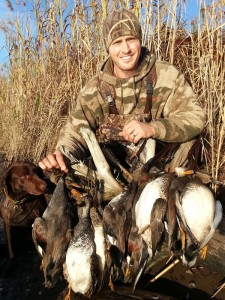If you are a follower of sunspots and tidal charts, like the folks at Farmer’s Almanac, the bitter cold winter we’ve been experiencing thus far should come as no surprise. If you are a modern day meteorologist, who has succumbed to naming winter storms for branding purposes, the series of artic fronts are “shocking” news and good for ratings. If you are a dyed-in-the-wool duck hunter, it’s just weather – the kind of weather that moves ducks and geese in a big way.
Hello folks, and, as always, welcome to Waterfowler.com.
Without a doubt, the extreme cold that was induced by the polar vortex the past week moved ducks and geese south. While the extremely low temperatures played a role in the migration activity, snow accumulation in the north played a much larger role in the event. In short, when the snow is too deep for ducks and geese to forage under, the head south in search of food and open water.
For may hunters in the Central and Mississippi Flyways, the snow accumulation has resulted in moving Canada Geese to wintering grounds they have not visited in years. The current snow cover map (link at right) reveals how far south the snowline has moved and the impact it will have on migration destinations.
Of course, winter storms of this nature remind us that hardy, northern ducks are not as fearful of cold temperatures as most duck hunters would hope. Duck activity along the extreme cold and snowline is near peak levels and yet just a few hundred miles to the south, duck counts are below average in many areas – even those not suffering from ongoing drought conditions.
If there is one thing storms of this nature remind us, ducks and geese do not move south on a whim. They are a very cold tolerant species and only move as far south as environmental conditions dictate.
As temperatures begin to rebound and warm over the next week, waterfowl activity along the snowline will continue to be good to excellent in most areas. In the Deep South, activity will slow as temperatures rise and birds spend more hours loafing than feeding – with nocturnal feeding becoming more prevalent in high pressure hunting areas.
For hunters in states that are enjoying the benefits of the Great Canada Goose migration of 2014, DOA DECOYS continues to offer a special member pricing on their full-bodied gunning decoys and some INSANE pricing on inventory clear outs – were members can save over $50 a carton.
PACIFIC FLYWAY:
Ongoing drought and relatively mild temperatures have continued to impact hunting in coastal states from the Pacific Northwest to the Southern California. Duck numbers from the Columbia Basin to Klamath remain fair to poor for this time of year. Duck and goose hunting in the Sacramento Valley is fair a best, with hunter success volatile and varied. In the eastern part of the flyway, colder temperatures, ice are near normal for this time of year with duck activity below average in Idaho, Utah and Nevada.
CENTRAL FLYWAY:
Artic temperatures pushed ducks and geese to the southern edge of the snowline in New Mexico and Oklahoma over the past week. Duck and goose numbers increased significantly from the Texas Pan Handle to Fort Worth. Hunting continues to be consistent along the Gulf Coast with pintail, widgeon and red head numbers good to excellent for this time of year.
MISSISSIPPI FLYWAY:
Thanks to an abundance of snow accumulation in the flyway, duck hunting is back in Arkansas and Canada Geese have returned to southern Illinois. While some extremely hardy ducks remain on open portions of the Mississippi River in the central portion of the flyway, the bulk of the fly population has been pushed into the southern third of the flyway. Hunting is good to excellent at this time from Arkansas to Louisiana – where they are happy to be shooting mallards again.
ATLANTIC FLYWAY:
The polar vortex and resulting Nor’easter storms resulted in a significant increase in migration activity last week. While ice continues to lock up northern areas, hunting remains fair to good from New Jersey to the Chesapeake Bay – where duck numbers are good to excellent all the way to Pamilico Sound. In the southern portion of the flyway, wood ducks, teal and ring necks continue to provide the primary action with mallard numbers rising.






